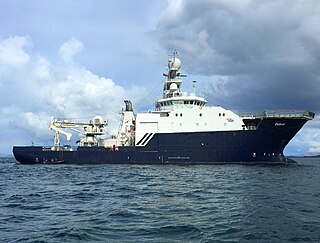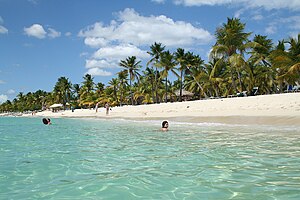
William Kidd also known as Captain William Kidd or simply Captain Kidd, was a Scottish privateer. Conflicting accounts exist regarding his early life, but he was likely born in Dundee and later settled in New York City. By 1690, Kidd had become a highly successful privateer, commissioned to protect English interests in North America and the West Indies.

Cozumel is an island and municipality in the Caribbean Sea off the eastern coast of Mexico's Yucatán Peninsula, opposite Playa del Carmen. It is separated from the mainland by the Cozumel Channel and is close to the Yucatán Channel. The municipality is part of the state of Quintana Roo, Mexico.

SS Yongala was a passenger steamship that was built in England in 1903 for the Adelaide Steamship Company. She sank in a cyclone off the coast of Queensland in 1911, with the loss of all 122 passengers and crew aboard.

A shipwreck is the wreckage of a ship that is located either beached on land or sunken to the bottom of a body of water. Shipwrecking may be intentional or unintentional. There were approximately three million shipwrecks worldwide as of January 1999, according to Angela Croome, a science writer and author who specialized in the history of underwater archaeology.

Wreck diving is recreational diving where the wreckage of ships, aircraft and other artificial structures are explored. The term is used mainly by recreational and technical divers. Professional divers, when diving on a shipwreck, generally refer to the specific task, such as salvage work, accident investigation or archaeological survey. Although most wreck dive sites are at shipwrecks, there is an increasing trend to scuttle retired ships to create artificial reef sites. Diving to crashed aircraft can also be considered wreck diving. The recreation of wreck diving makes no distinction as to how the vessel ended up on the bottom.

Isla de Providencia, historically Old Providence, and generally known as Providencia or Providence, is a mountainous Caribbean island that is part of the Colombian department of Archipelago of San Andrés, Providencia and Santa Catalina and the municipality of Providencia and Santa Catalina Islands, lying midway between Costa Rica and Jamaica.

The archaeology of shipwrecks is the field of archaeology specialized most commonly in the study and exploration of shipwrecks. Its techniques combine those of archaeology with those of diving to become Underwater archaeology. However, shipwrecks are discovered on what have become terrestrial sites.

The Lofthus is a Norwegian shipwreck near Boynton Beach, Florida, United States. Built in 1868 in Sunderland, England by T.R. Oswald, the 222-foot iron-hulled vessel was originally christened Cashmere and rigged as a three masted barque. She was painted with false gunports to ward off Sumatran and Javanese pirates. After a career in the East Indian trade Cashmere was sold to a Norwegian firm, renamed Lofthus, and used in the American trade. On February 4, 1898, the Lofthaus wrecked in a storm en route to Buenos Aires, Argentina from Pensacola, Florida. The crew of 16 men, as well as the ship's cat and dog were rescued by the passing vessel Three Friends, which was smuggling guns to Cuba. The ship, however, was declared a loss as it could not be removed from the shallow reef. The cargo, primarily lumber, was salvaged and brought ashore by locals and reportedly used to build homes in the Boynton Beach area.

The Bellairs Research Institute, located on the Caribbean island of Barbados, was founded in 1954 as a marine biology field-station for McGill University. The main campus of McGill University is in Montreal, Quebec, Canada.
The year 2007 in archaeology

Monte Cristi Pipe Wreck is a submerged archaeological site located off the north coast of Hispaniola in the Dominican Republic near the border of Haiti, part of the Greater Antilles in the Caribbean. The site is one of the hundreds of historic shipwrecks that lie on the ocean floor between Monte Cristi and Puerto Plata.
Quedagh Merchant, also known as the Cara Merchant and the Adventure Prize, was an Indian merchant vessel famously captured by Scottish privateer William Kidd on 30 January 1698.

Sinking ships for wreck diving sites is the practice of scuttling old ships to produce artificial reefs suitable for wreck diving, to benefit from commercial revenues from recreational diving of the shipwreck, or to produce a diver training site.
The Center for Maritime Archaeology and Conservation (CMAC) was created in May 2005 by the regents of Texas A&M University.

The Ayas Nautical Research Club was founded in 1985. The range of its activities includes historical aspects of World and Armenian navigation and shipbuilding, reconstruction of ancient Armenian vessels, study of sea routes, old maps, navigation devices, banners, collecting data on Armenian navigators, making underwater archaeological surveys and research. Since 1985 the Club has organized 15 exhibitions and has carried out several surveys on Armenian navigation. It has restored and reconstructed 26 different types of vessels used in historical Armenia. Members of the Club participate at international conferences on underwater archaeology and nautical history and have published a number of articles.
Captain Kidd's cannon is an iron cannon that was discovered in 2007 off of the coast of Catalina Island in the Dominican Republic. The cannon is believed to be part of the wreckage of the Quedagh Merchant, a ship that was commandeered and later abandoned by Captain Kidd in 1699. It is the first pirate cannon that has been recovered from the Caribbean. It's one of 26 cannons found off the coast of Catalina Island. It was first taken to Indiana University's School of Health, Physical Education, and Recreation for investigation and research before being displayed in the exhibit National Geographic: Treasures of the Earth at The Children's Museum of Indianapolis in Indianapolis, Indiana.

Recreational dive sites are specific places that recreational scuba divers go to enjoy the underwater environment or for training purposes. They include technical diving sites beyond the range generally accepted for recreational diving. In this context all diving done for recreational purposes is included. Professional diving tends to be done where the job is, and with the exception of diver training and leading groups of recreational divers, does not generally occur at specific sites chosen for their easy access, pleasant conditions or interesting features.

The Florida Public Archaeology Network, or FPAN, is a state supported organization of regional centers dedicated to public outreach and assisting Florida municipalities and the Florida Division of Historical Resources "to promote the stewardship and protection of Florida's archaeological resources." FPAN was established in 2004, upon legislation that sought to establish a "Florida network of public archaeology centers to help stem the rapid deterioration of this state's buried past and to expand public interest in archaeology."

RV Petrel, or R/V Petrel, is a 76.45 m (250.8 ft) research vessel owned by the United States Navy and once owned by Microsoft co-founder Paul Allen. The ship is named after the petrel, a sea bird. The ship was completed by Brattvaag Skipsverft, Norway in 2003 as the deepwater offshore inspection vessel Seaway Petrel for service with Stolt Offshore. She was later renamed Acergy Petrel, then Seven Petrel with Subsea 7.
















